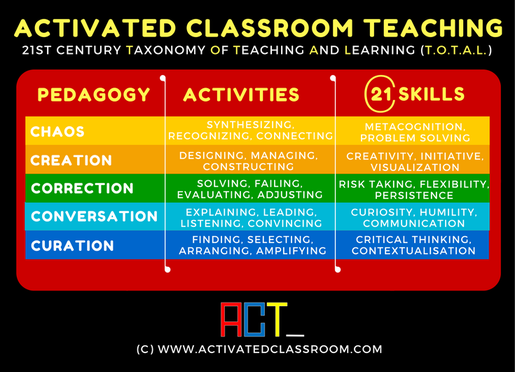
Summary: In this article, I will discuss how our attempt to fix our education crisis has staggered from one approach to another. First, we threw lots of tech at the problem, and this resulted in billion-dollar failures. Then we threw lots of money at training teachers to use tech, and still, we are seeing failures. It is only when we realise what is really wrong that we can effectively change how we teach.
“Hi Craig, I wonder if you could come and talk to our teachers about using technology for teaching?” reads the email I’ve just opened. I receive many emails like this and so I’m fairly sure what I will find when I get to this school.
I arrive and am soon set up in the school auditorium. Typically, the session is scheduled after school – often on a Friday afternoon. As the room slowly fills with teachers I can already read their expressions – “Why do they force us to attend these sessions?” – “Not another presentation on using computers”.
As I stand up I can see most people are looking at their devices. I suppose that’s what I’d be doing at an after school session like this. I lean forward and speak into the microphone. “The worst thing we can do is train teachers to use technology.” I pause. Heads pop up. I can see them replaying what I just said in their minds, wondering if they heard correctly. I can see the questions forming. “Wasn’t this guy meant to be telling us how to use computers?” I wait for the confusion to take hold and then I continue.
The worst thing we can do is train teachers to use technology…
The second worst thing is doing nothing.
That hasn’t helped. If anything they are now even more confused. Excellent! Now that I have everyone’s attention I have a precious moment – a teachable moment. That moment that every teacher desires – when our students are attentive, enquiring, wanting to hear more
Who’s to blame?
I keep coming across articles that attempt to explain how we can fix the modern education crisis. Yes, there is a crisis. It doesn’t take studies to tell us that our world has changed dramatically and our teaching hasn’t kept up.
Our students have a daily digital diet of approx. 9 hours of tech consumption. The impact is attention spans are reported to have dropped to 8 seconds – apparently below that of a goldfish. Whether this is true or not, what is true is that most teachers are struggling to keep students engaged.

So how do we reconnect with our students? How do we make our teaching relevant in the digital age? The solution seems obvious. If technology is what engages the modern generation outside the classroom, then let’s use it in the classroom. After all technology has revolutionized all other aspects of life – business, entertainment, communication, sports. It only makes sense that education needs the same revolution.
And so our first attempt to fix our classrooms saw us investing billions in technology – iPads, Chrome Books, smartboards flooded into schools. And the result? At the best, we could call it a mixed success. However, many would call it a failure. Headlines telling the costly story of the failed Los Angles iPad program or research proclaiming that technology in the classroom is reducing students’ grades.

Something’s just not right. Surely technology should have solved our education issues, not exacerbated them. What’s going wrong? Is it the technology to blame or is it the teachers? It seems unlikely it’s the tech – it has proven itself in so many other areas – so maybe it is the teachers. And so now we are seeing headlines like:

That makes sense. Edtech is failing because teachers haven’t been trained to use the technology. And that’s why I find myself standing before this audience. This is our second attempt at addressing our modern education issues – throw money at training teachers to use technology. And once again vendors have been quick to respond to this by eagerly offering courses on how to use the plethora of tools that exist.
But we have lost sight of something fundamental in our headlong rush to modernise education.
It’s not training teachers to use technology that we need, it’s training teachers to teach with technology.
The difference between “use” and “teach” has profound implications. The best way to understand what’s going wrong, and why I began my presentation by saying “The worst thing we can do is train teachers to use technology” is to think about cakes.
A lesson from Master Chef
Imagine some children enthused to bake their own cake after watching endless seasons of Master Chef. They’re in the kitchen surrounded by everything they need – ingredients, equipment, and dollops of enthusiasm.
After hours of mixing and beating, laughing and chatting, delicious smells are wafting from the kitchen. Finally, the moment arrives. The cake is ready. The oven is opened. You reach in to extract the delicious smelling masterpiece as the children look on fibrillating in anticipation. The cake is perf….flat! It is splayed across the baking tray inelegantly like a beginner skier on a ski slope. How could all their passion, ingredients, and tools result in this disaster? Quite simple – there was no recipe. And the same applies to education.
Even the best technology mixed with enthused teachers and sprinkled liberally with the latest tech won’t ensure success.
My Epic Fail
I look back at my countless forays into using technology for teaching and how often it fell flat – despite my passion and belief that it would work.
I recall one ambitious attempt in particular. I was so excited about the potential of 3D virtual worlds that I got my students to build a replica of our university – everything from the library to the lecture theatres. The detail was amazing. And so it was with great excitement that I stood at the front of a virtual lecture theatre prepared to deliver my first lesson. It took a while to settle them down as a flood of text streamed across my screen as the students “talked”. Finally, I managed to instil some order by SHOUTING (typing in uppercase) to make myself “heard”.
Behind me, the first slide of my presentation was displayed. “GOOD MORNING CLASS,” I typed. “TODAY WE WILL…” and so I began explaining what was on the slide. While the talking had eased off, students were still morphing into animals, flying, walking…I pushed on. I clicked “Next” to move to the next slide. Nothing happened. I clicked again. Nothing. Again. Suddenly the presentation jumped three slides. “Oh no,” I groaned hunched over my computer.
Finally, I got to the right slide. “IN THIS SLIDE WE SEE,” I slowly typed as I explained the slide. Half my time was up and we had only completed two slides. It’s then that it hit me – “What am I doing? This is a poor substitute for a real lecture. In fact, I would have been better off emailing the slides to the students than doing this. This just hasn’t worked. Is it the tech, or is it me?”
Using or Teaching
It’s not the tech. It’s not the teachers. It’s the missing recipe. In teacher talk the recipe is called pedagogy, but somehow we seem to have forgotten all about pedagogy.

Somewhere in our enthusiasm to fix our education challenges technology has become a proxy for pedagogy .
Herein lies our problem – where training teachers to use technology is assumed to be the same as training teachers to teach with technology. It’s akin to assuming that because you know how to use a drill and nail gun you know how to build a house.
Just because a teacher has been trained to use Google Docs, or YouTube, or Edmodo, does not mean they know how to teach with these tools. This begs the question. Why have we ignored pedagogy – something all student teachers learn about, something all teachers know is vital? Could it be that our digital education agenda is now driven by technology companies? In fact, why are technology companies telling teachers how to teach? Or maybe pedagogy has been forgotten because we are mesmerised by all the tools, or maybe it’s our lack of understanding of how modern students learn.
Education’s Missing Recipe
What we need, if we are going to realize the opportunities that technology can bring to education, is an easy-to-apply, effective, and appropriate set of digital-age pedagogies.
- Easy-to-apply – One of the most widely applied tools in education, because of its powerful simplicity, is Bloom’s taxonomy of thinking. This ordered arrangement helps teachers easily align teaching and assessment. The same is required for modern teaching – an easy-to-apply taxonomy of digital-age pedagogies.
- Effective – We can’t simply copy our old pedagogies and paste them into the digital age. My failed virtual world foray is one example of why this does not work. In fact, there is a mounting body of research that points to the need for approaches that encourage active learning rather than passive consumption. We need effective approaches that encourage active teaching and learning.
- Appropriate – Our issues have arisen because our students are engaging, connecting, and learning in new ways. Appropriate pedagogies need to resonate with how our modern students learn and at the same time leverage the affordances that technology offers.
What is required is not just digital age pedagogies but a Taxonomy Of Teaching And Learning (TOTAL) digital-age pedagogies.
#ACT_ Approach
Designing a TOTAL digital-age approach requires an understanding of how modern students use technology, as well as the intentional and unintentional affordances provided by technology. It was extensive research into this that gave rise to the Activated Classroom Teaching (ACT) model – the first cohesive taxonomy of digital-age pedagogies.
The ACT model provides educators with an arrangement of five active learning pedagogies for teaching in the digital age. These pedagogies allow teachers to focus on teaching then technology.

The best thing we can do
So, why is training teachers to use technology the worst thing we can do? Quite simply because as our education issues continue and it’s not the teachers to blame – as they have now been trained – it must be the technology to blame. And this is exactly what we are seeing in a new wave of reports proclaiming the failure of technology in the classroom. However, the issue lies not with the technology or with our teachers, but with our training.
The auditorium is quiet. Everyone is waiting to hear what I say next. A moment of attention, so rare in our modern world. I grasp this teachable moment and say,
“The worst thing we can do is train teachers to use technology…The best thing we can do is train teachers to teach with technology.”




